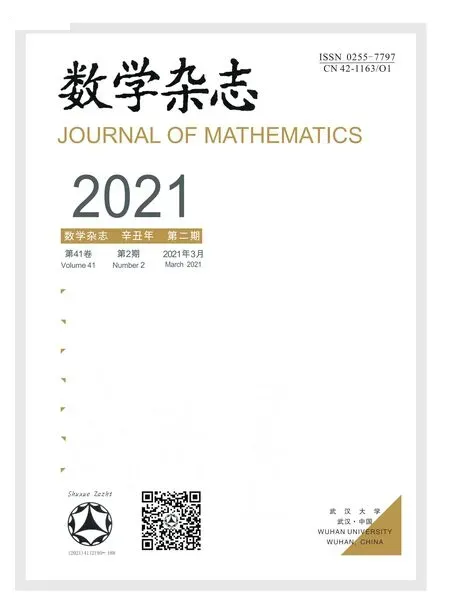ABSTRACT CAUCHY-KOVALEVSKAYA THEOREM IN GEVREY SPACE:ENERGY METHOD
CHEN Jun-ling
(School of Mathematics and Statistics,Wuhan University,Wuhan 430072,China)
Abstract:In this paper,we study the well-posedness of nonlinear Cauchy problem.The main tool is the combination of the classical energy method and abstract Cauchy-Kovalevskaya Theorem.We obtain that the nonlinear Cauchy problem is well-posed in the Gevrey space,which is an extension on the existing literature in the aspect of well-posedness for the nonlinear Cauchy problem.
Keywords:Cauchy-Kovalevakaya theorem;Gevrey space;energy method;Cauchy problem
1 Introduction and Main Results
As early as 1918,M.Gevrey first proposed the concept of smoothness of Gevrey classes in[1].Gevrey class is a function space which lies between analytic class andC∞function space.Accurately speaking,J.Hadamard put forward a similar concept quasianalytic class earlier in[2],while Gevrey class can be regarded as a special case of quasianalytic class.As we all konw,it is not very convenient to solve general partial differential equations because of the mathematical characterization ofC∞smoothness.But for the analyticCωsmoothness,we have the Cauchy-Kovalevskaya theorem on local existence.Cauchy-Kovalevskaya Theorem[3]tells us that as long as the coefficients of the equations are analytic,the solutions of the non-characteristic Cauchy problems of higher order differential equations exist at least locally,although we can’t get the continuous dependence of the solutions.In order to extend the abstract Cauchy-Kovalevakaya theorem to the non-analytic function set,M.Gevrey introduced the concept of Gevrey class.Then,in the study of quasianalytic function class,La Vallée Poussin and his collaborators found that Gevrey class functions could be described by exponential decay of their Fourier coefficients in[4],which was later reflected in[5]by J.Kopeé and J.Musielak.Although mathematicians knew the equivalent description of Fourier coefficients of Gevrey class space for a long time,they didn’t know that it had other applications at that time.Until 1989,C.Foias and R.Temam creatively applied this Fourier space technique in[6].At present,it is a standard practice to study the analytic properties of solutions of a large class to dissipative equations in different function spaces,which is due to Fourier space method of Gevrey class functions,and their work is much simpler than the earlier method that C.Kahane used the original definition of Gevrey class in[7]to analyze the analytic properties of solutions to the incompressible Navier-Stokes equations.
The most suitable function space for studying hydrodynamic equations is Sobolev space,because the definition of energy in Sobolev space is very simple.However,many basic problems of hydrodynamic equations have not been satisfactorily worked in Sobolev space.For example,Prandtl boundary layer problem is ill-posed in Sobolev space in many cases.On the other hand,according to Cauchy-Kovalevskaya theorem,these equations are locally solvable in the analytic function space.However,analytic function space does not contain compactly supported functions,so it is not the suitable function space for studying hydrodynamic equations.Therefore,Gevrey space,the transition space between Sobolev space and analytic function space,is naturally considered.Now,we recall the definition for the functions in the Gevrey class.Let ? be an open subset of Rdand 1≤s<+∞.fis the real value function defined on ?.We say thatf∈Gs(?)iff∈C∞(?)and for any compact subsetKof ?,there exists a constant(say Gevrey constant off)C=CK,depending only onKandf,such that for all multi-indicesα∈Nd,

IfWis a closed subset of Rd,Gs(W)denotes the restriction ofonWwhereis an open neighborhood ofW.The condition(1.1)is equivalent to the following estimate(see[8,9]):

Now,let us pay attention to the following abstract Cauchy problem:

in a Hilbert spaceH,whereA(t)is a nonnegative unbound operator.IfA(t)satisfies some strict coercivity assumptions,i.e.when the equation in(1.2)is strictly hyperbolic,the local solvability for the Cauchy problem(1.2)is well-known,providedA(t)is Lipschitz continuous in time andfis smooth enough.Kato gave an extensive theory on this problem,including most of the concrete results in the Sobolev space with optimal regularity assumptions.(see[10,11])On the other hand,whenA(t)≥0 is allowed to be degenerate,i.e.when the equation of(1.2)is weakly hyperbolic,we need much stronger assumptions in order that the Cauchy problem(1.2)is locally solvable.This is the same to linear equations such as

which may not be locally solvable inC∞for a suitable nonnegativea(t)∈C∞.It is possible to overcome this difficulty by requiring that the data and the coefficients are more regular in space variables.It was proved in[12,13]that the equations

are globally sovable in the Gevrey space.Besides,the case of hyperbolic equations of higher order was proved in[14].If the coefficientsaijare H¨older continuous in time with exponentλand Gevrey of ordersinx,then(1.4)is uniquely solvable inGs(Rd)provided

and locally solvable if there is equality in(1.5).A conjecture was inspired by these remarks that an equation like

may be locally solvable in Gevrey classes,provided the functionfhas suitable smoothness properties.In 1967,Leray and Ohya proved that if the system is(weakly)hyperbolic with smooth characteristic roots,the Cauchy problem for the general semilinear system is wellposed in the Gevrey class in[15].And Kajitani removed the assumption of smoothness.Besides,he further improved the result by showing that it was sufficient to assume H¨older continuity in time of the coefficients,provided(1.5)holds.
In this paper,we discuss the existence and uniqueness of local solution in the Gervey space to the following abstract Cauchy problem:

whereQ∞,T=R×(0,T]andF(t,?xu)are analytic with respect to bothxandt.
Now,we will introduce the Gevrey function space.
definition 1.1Let 0<ρ<1,the Gevrey function spaceGρconsists of all smooth vector-valued functionsusuch that the Gevrey normkukρ<+∞,wherek·kρis defined below.We define

Our result can be stated as follows.
Theorem 1.1Suppose the initial datumu0andv0belong toGρ0for someρ0>0.Then the system(1.7)admits a unique solutionu∈L∞?[0,T];Gρ¢for someT>0 and some 0<ρ<ρ0≤1.
Remark 1.1Similar results also hold with different Gevrey index for more general Cauchy problem

The rest of this paper is organized as follows.In Section 2,we will prove a priori estimate.In Section 3,we will prove the Theorem 1.1.
2 A Priori Estimate



3 Proof of the Main Result




